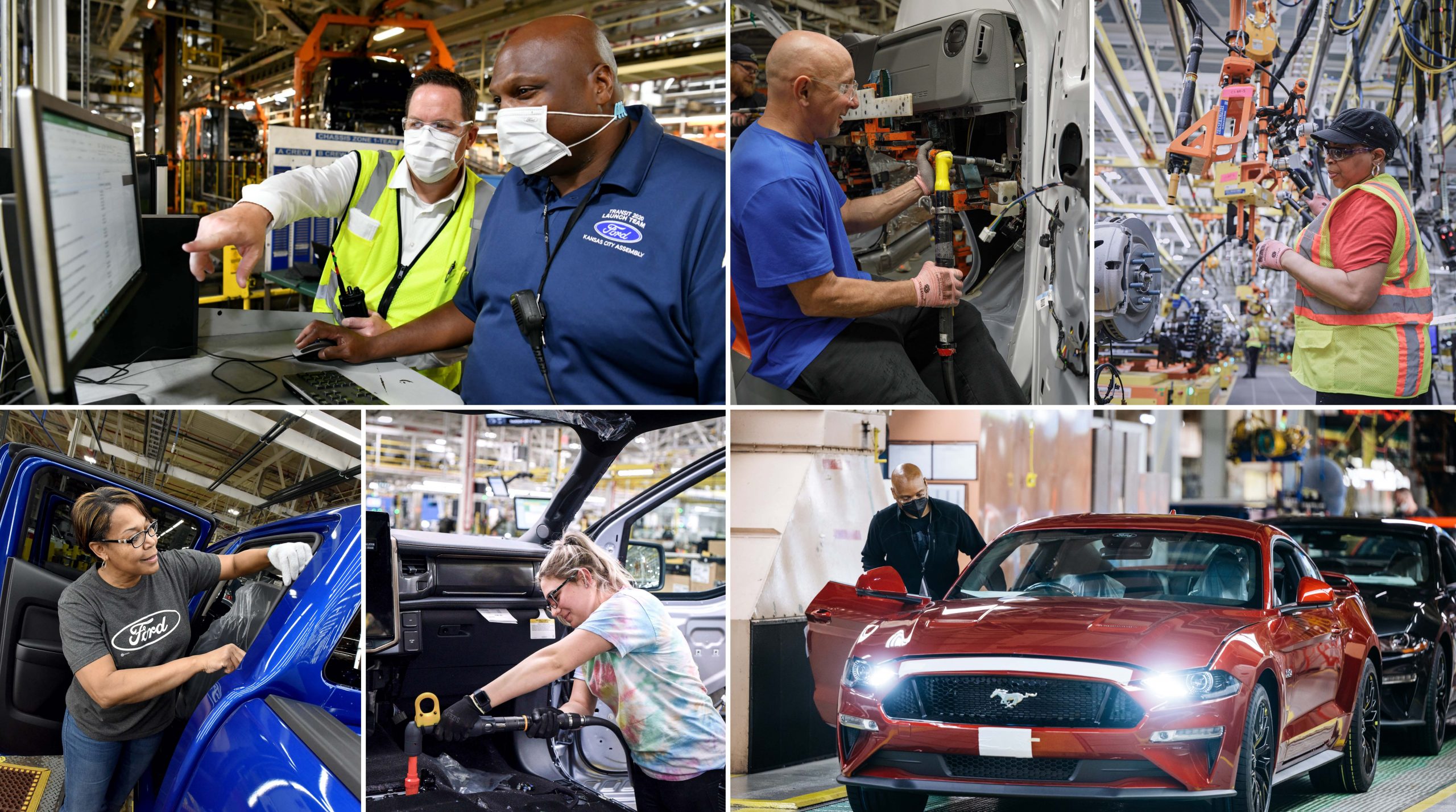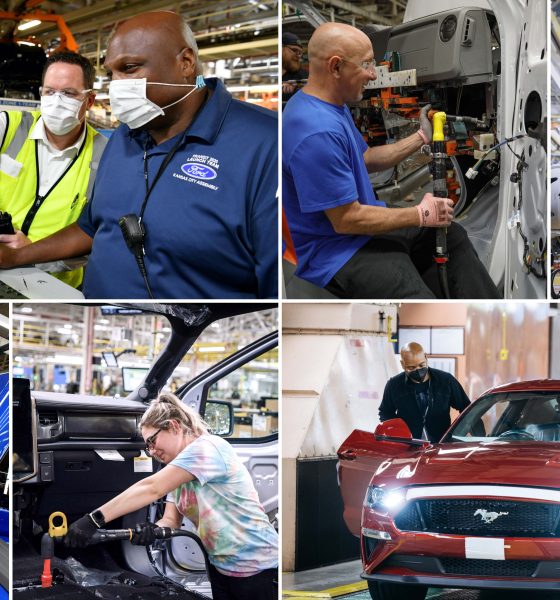

News
Ford to invest $4.7B to improve manufacturing plants & add 6,200 UAW employees to workforce
Ford plans to invest $3.7 billion to add over 6,200 union jobs to its manufacturing plants in Michigan, Ohio, and Missouri. The legacy OEM also plans to invest another $1 billion in the next five years to improve the workplace environment in its factories based in the United States.
Besides adding 6,200 permanent Union Auto Workers (UAW) employees, Ford also expects its $3.7 billion investment to indirectly generate an estimated 74,000 new jobs in the U.S. by the end of 2026. The traditional automaker plans to convert 3,000 temporary employees into permanent full-time workers with immediate health benefits on the first day of employment.
“Ford is America’s Number 1 employer of hourly autoworkers, and this investment only deepens our commitment to building great new vehicles – from an all-new Mustang to new EVs – right here in the U.S. in partnership with the UAW,” said Bill Ford, executive chair of Ford. “I am proud that we are investing in the Midwest and taking real action to provide better benefits and working conditions for our workers on the plant floor.”
Ford’s $3.7 billion investment is broken down by factory below.
- Michigan: Ford plans to invest $2 billion in Michigan, generating 3,200 union jobs. The investment will create nearly 2,000 jobs throughout three assembly plants in Michigan. The new assembly plant jobs will increase production of the all-new F-150 Lightning electric truck to 150,000 per year at Rouge Electric Vehicle Center in Dearborn, produce an all-new Ranger pickup at Michigan Assembly Plant in Wayne and an all-new Mustang coupe at Flat Rock Assembly Plant. The billion-dollar investment includes $35 million to build an all-new Ford Customer Service Division packaging facility in Monroe that will create more than 600 union jobs. The Ford Customer Service Division is expected to start operations by 2024 to help accelerate parts shipments for Ford customers.
- Ohio: Ford plans to invest $1.5 billion in Ohio, creating 1,800 union jobs at Ohio Assembly Plant. It plans to generate an additional 90 jobs with $100 million investments between Lima Engine and Sharonville Transmission plants.
- Missouri: In Missouri, Ford plans to make a $95 million investment. The investment will generate 1,100 union jobs for a third shift at Kansas City Assembly Plant. More workers would increase the production of the Transit and the all-new E-Transit electric van.
The automaker and the UAW supported Bill Ford’s words by announcing new vehicles, plant investments, and workplace improvements before formally agreeing on a new union contract. The current UAW contract expires in 2023.
“This announcement is a testament to UAW members who contribute their skill, experience and knowledge to the success of Ford Motor Company,” said UAW President Ray Curry. “We are always advocating to employers and legislators that union jobs are worth the investment. Ford stepped up to the plate by adding these jobs and converting 3,000 UAW members to permanent, full-time status with benefits.”
Besides the $3.7 billion investment, Ford plans to invest another $1 billion to improve the employee facilities in its manufacturing plants. The $1B investment will give employees access to healthier foods, install EV chargers in the parking lots, add more lighting in the parking area, and make other changes. Ford stated that each plant would have different improvements.
Ford aims to produce 2 million electric vehicles per year globally by 2026 through its Ford Model e trademark—a separate operation dedicated to EV production. Ford Blue is dedicated to the company’s internal combustion engine businesses. Besides its investment announcements, Ford also confirmed the launch of an all-new electric commercial vehicle for Ford Pro customers in Ohio. The Ford Pro electric commercial vehicle is expected to debut “mid-decade.”
The Teslarati team would appreciate hearing from you. If you have any tips, reach out to me at maria@teslarati.com or via Twitter @Writer_01001101.

News
Tesla FSD fleet is nearing 7 billion total miles, including 2.5 billion city miles
As can be seen on Tesla’s official FSD webpage, vehicles equipped with the system have now navigated over 6.99 billion miles.

Tesla’s Full Self-Driving (Supervised) fleet is closing in on almost 7 billion total miles driven, as per data posted by the company on its official FSD webpage.
These figures hint at the massive scale of data fueling Tesla’s rapid FSD improvements, which have been quite notable as of late.
FSD mileage milestones
As can be seen on Tesla’s official FSD webpage, vehicles equipped with the system have now navigated over 6.99 billion miles. Tesla owner and avid FSD tester Whole Mars Catalog also shared a screenshot indicating that from the nearly 7 billion miles traveled by the FSD fleet, more than 2.5 billion miles were driven inside cities.
City miles are particularly valuable for complex urban scenarios like unprotected turns, pedestrian interactions, and traffic lights. This is also the difference-maker for FSD, as only complex solutions, such as Waymo’s self-driving taxis, operate similarly on inner-city streets. And even then, incidents such as the San Francisco blackouts have proven challenging for sensor-rich vehicles like Waymos.
Tesla’s data edge
Tesla has a number of advantages in the autonomous vehicle sector, one of which is the size of its fleet and the number of vehicles training FSD on real-world roads. Tesla’s nearly 7 billion FSD miles then allow the company to roll out updates that make its vehicles behave like they are being driven by experienced drivers, even if they are operating on their own.
So notable are Tesla’s improvements to FSD that NVIDIA Director of Robotics Jim Fan, after experiencing FSD v14, noted that the system is the first AI that passes what he described as a “Physical Turing Test.”
“Despite knowing exactly how robot learning works, I still find it magical watching the steering wheel turn by itself. First it feels surreal, next it becomes routine. Then, like the smartphone, taking it away actively hurts. This is how humanity gets rewired and glued to god-like technologies,” Fan wrote in a post on X.
News
Tesla starts showing how FSD will change lives in Europe
Local officials tested the system on narrow country roads and were impressed by FSD’s smooth, human-like driving, with some calling the service a game-changer for everyday life in areas that are far from urban centers.

Tesla has launched Europe’s first public shuttle service using Full Self-Driving (Supervised) in the rural Eifelkreis Bitburg-Prüm region of Germany, demonstrating how the technology can restore independence and mobility for people who struggle with limited transport options.
Local officials tested the system on narrow country roads and were impressed by FSD’s smooth, human-like driving, with some calling the service a game-changer for everyday life in areas that are far from urban centers.
Officials see real impact on rural residents
Arzfeld Mayor Johannes Kuhl and District Administrator Andreas Kruppert personally tested the Tesla shuttle service. This allowed them to see just how well FSD navigated winding lanes and rural roads confidently. Kruppert said, “Autonomous driving sounds like science fiction to many, but we simply see here that it works totally well in rural regions too.” Kuhl, for his part, also noted that FSD “feels like a very experienced driver.”
The pilot complements the area’s “Citizen Bus” program, which provides on-demand rides for elderly residents who can no longer drive themselves. Tesla Europe shared a video of a demonstration of the service, highlighting how FSD gives people their freedom back, even in places where public transport is not as prevalent.
What the Ministry for Economic Affairs and Transport says
Rhineland-Palatinate’s Minister Daniela Schmitt supported the project, praising the collaboration that made this “first of its kind in Europe” possible. As per the ministry, the rural rollout for the service shows FSD’s potential beyond major cities, and it delivers tangible benefits like grocery runs, doctor visits, and social connections for isolated residents.
“Reliable and flexible mobility is especially vital in rural areas. With the launch of a shuttle service using self-driving vehicles (FSD supervised) by Tesla in the Eifelkreis Bitburg-Prüm, an innovative pilot project is now getting underway that complements local community bus services. It is the first project of its kind in Europe.
“The result is a real gain for rural mobility: greater accessibility, more flexibility and tangible benefits for everyday life. A strong signal for innovation, cooperation and future-oriented mobility beyond urban centers,” the ministry wrote in a LinkedIn post.
News
Tesla China quietly posts Robotaxi-related job listing
Tesla China is currently seeking a Low Voltage Electrical Engineer to work on circuit board design for the company’s autonomous vehicles.

Tesla has posted a new job listing in Shanghai explicitly tied to its Robotaxi program, fueling speculation that the company is preparing to launch its dedicated autonomous ride-hailing service in China.
As noted in the listing, Tesla China is currently seeking a Low Voltage Electrical Engineer to work on circuit board design for the company’s autonomous vehicles.
Robotaxi-specific role
The listing, which was shared on social media platform X by industry watcher @tslaming, suggested that Tesla China is looking to fill the role urgently. The job listing itself specifically mentions that the person hired for the role will be working on the Low Voltage Hardware team, which would design the circuit boards that would serve as the nervous system of the Robotaxi.
Key tasks for the role, as indicated in the job listing, include collaboration with PCB layout, firmware, mechanical, program management, and validation teams, among other responsibilities. The role is based in Shanghai.
China Robotaxi launch
China represents a massive potential market for robotaxis, with its dense urban centers and supportive policies in select cities. Tesla has limited permission to roll out FSD in the country, though despite this, its vehicles have been hailed as among the best in the market when it comes to autonomous features. So far, at least, it appears that China supports Tesla’s FSD and Robotaxi rollout.
This was hinted at in November, when Tesla brought the Cybercab to the 8th China International Import Expo (CIIE) in Shanghai, marking the first time that the autonomous two-seater was brought to the Asia-Pacific region. The vehicle, despite not having a release date in China, received a significant amount of interest among the event’s attendees.








